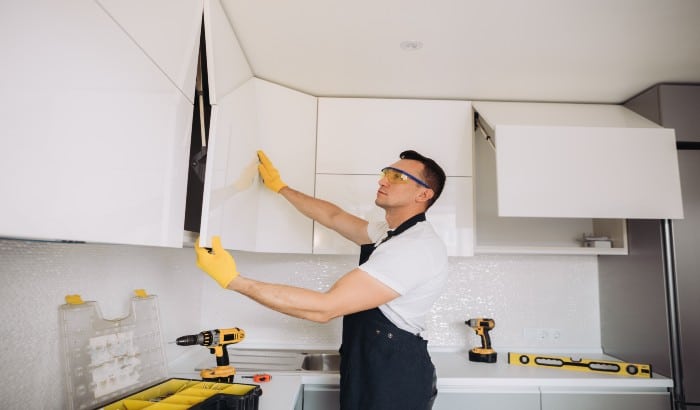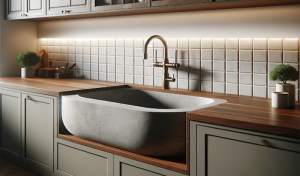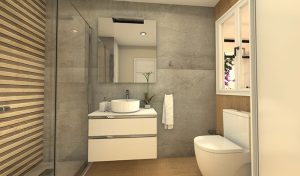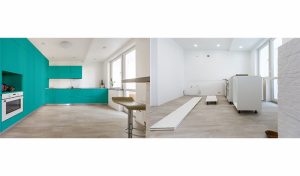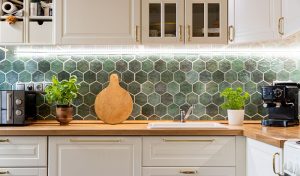If you have begun the process of remodeling your kitchen, you are probably facing the decision between melamine or plywood kitchen cabinets.
It is rare for cabinets to be constructed entirely from solid wood these days, and manufactured wood products are often used to build the cabinet boxes. There are great reasons for using plywood or melamine rather than solid wood, and each material also has its own perks. Here is a primer on why these products are used, and the pros and cons you will want to consider as you decide which material is right for your kitchen cabinets.
Why Use Manufactured Wood Products
You may be wondering why cabinetmakers do not often use solid wood when constructing cabinets. One main reason is that solid wood expands and contracts and can experience cracking, bowing, sagging, or warping. Manufactured wood products offer a more stable, uniform material. The cost difference is another consideration, as premium quality wood costs more than a manufactured product like melamine or plywood. In many cases, using solid wood simply is not an affordable option.
Another factor is that the cabinet boxes are largely unseen; using beautifully grained wood on the cabinet doors will look just as high end and custom as a solid construction. Finally, for cabinets that are a solid color, such as white or the popular putty, blues, or greens of today’s kitchen designs, wood grain will not show. In fact, the manufactured wood products like melamine may be preferable in these cases, as they provide a completely smooth surface free from knots or other imperfections.
The Pros and Cons of Melamine or Plywood Cabinet Construction
Both melamine and plywood are manufactured wood products, each created through a slightly different process. Melamine is particleboard or small pieces of wood glued and pressed together, covered with a plasticized coating. By contrast, plywood is made from thin sheets of wood, layered and glued together. The sheets are usually laid perpendicular to each other to increase the strength of the finished product and to help resist splitting. Here are a few things to keep in mind about the features of each product:
Melamine
-
- Pros
- Melamine is the same resin used in Formica and other laminated countertops. It offers a smooth, easy to clean finish that is ready to use without much construction waste or need to paint or stain.
- The particleboard can be made from sustainably-grown wood and is glued together with moisture-resistant products. This makes it a cost-effective product with little waste.
- Cutting melamine is easily done with the right equipment. Using a saw with a scoring unit and CNC routers helps to prevent chipping. Supporting the material while cutting is also important to prevent breaking.
- Melamine offers a smooth, uniform surface that is very durable, moisture resistant, and easy to clean.
- The lack of wood grain is actually preferred by many people who want solid colored cabinets, and melamine can come prefinished in a variety of colors.
- Cons
- Under pressure, melamine can crack or break, but it will not split.
- The glues used in the construction of melamine boards can emit VOCs (volatile organic compounds) into the air. However, for these products to be sold in the United States, they must be correctly labeled and adhere to EPA (United States Environmental Protection Agency) safety standards for emissions.
- Due to the composite nature of the material, traditional melamine can be quite dense and heavy.
- Pros
Plywood
-
- Pros
- Plywood can be an easier material to work with than melamine-encased boards. Since the material is less dense, it is both easier to cut and assemble plywood cabinet boxes with standard tools, screws, and nails.
- Cabinets constructed from plywood are lighter, making them a great option for upper cabinets.
- Plywood still offers the look of natural wood grain since it is made from layered sheets of wood.
- Cons
- Plywood can have knot holes, rough surfaces, or other defects that require finishing.
- In order to match the direction of the grain in plywood, more material must be used, and there can be more waste when building cabinets.
- Generally, plywood is more expensive than melamine.
- Pros
Mountain States Kitchen and Bath Can Help You Choose the Right Product
In the end, the choice often comes down to preference. As the consumer, the right product will meet your desired results and requirements. Both melamine and plywood are cost-effective, durable products that will provide quality construction. Depending on the look you want for your kitchen cabinets and the overall design of your kitchen, one may be a better choice over the other.
Fortunately, Mountain States Kitchen and Bath has both experienced designers and cabinet makers that will help guide you through the process of designing your dream kitchen and making the choice between melamine or plywood cabinets. Our locally-owned Utah company offers complimentary consultations. Contact us today to schedule a meeting and get your custom cabinet project underway! We serve Lehi, Utah, and the surrounding area.
Contact Us
[contact-form-7 id=”36200″]

